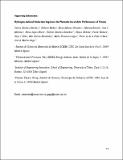Por favor, use este identificador para citar o enlazar a este item:
http://hdl.handle.net/10261/350538COMPARTIR / EXPORTAR:
 SHARE SHARE
 CORE
BASE CORE
BASE
|
|
| Visualizar otros formatos: MARC | Dublin Core | RDF | ORE | MODS | METS | DIDL | DATACITE | |

| Título: | Hydrogen-Induced Reduction Improves the Photoelectrocatalytic Performance of Titania |
Autor: | Sánchez-Sánchez, Carlos CSIC ORCID ; Muñoz, Roberto CSIC ORCID; Alfonso-González, Elena; Barawi, Mariam; Martínez, José I. CSIC ORCID ; López-Elvira, Elena ; Sánchez-Santolino, Gabriel; Shibata, Naoya; Ikuhara, Yuichi; Ellis, Gary J.; García-Hernández, Mar CSIC ORCID ; López, María Francisca CSIC ORCID ; Peña O'Shea, Víctor A. de la; Martín-Gago, José A. CSIC ORCID | Palabras clave: | Etching Hydrogen Oxides Plasma Scanning tunneling microscopy |
Fecha de publicación: | 20-feb-2024 | Editor: | American Chemical Society | Citación: | ACS Applied Energy Materials 2024 | Resumen: | One of the main challenges to expand the use of titanium dioxide (titania) as a photocatalyst is related to its large band gap energy and the lack of an atomic scale description of the reduction mechanisms that may tailor the photocatalytic properties. We show that rutile TiO2 single crystals annealed in the presence of atomic hydrogen experience a strong reduction and structural rearrangement, yielding a material that exhibits enhanced light absorption, which extends from the ultraviolet to the near-infrared (NIR) spectral range, and improved photoelectrocatalytic performance. We demonstrate that both magnitudes behave oppositely: heavy/mild plasma reduction treatments lead to large/negligible spectral absorption changes and poor/enhanced (×10) photoelectrocatalytic performance, as judged from the higher photocurrent. To correlate the photoelectrochemical performance with the atomic and chemical structures of the hydrogen-reduced materials, we have modeled the process with in situ scanning tunneling microscopy measurements, which allow us to determine the initial stages of oxygen desorption and the desorption/diffusion of Ti atoms from the surface. This multiscale study opens a door toward improved materials for diverse applications such as more efficient rutile TiO2-based photoelectrocatalysts, green photothermal absorbers for solar energy applications, or NIR-sensing materials. | Versión del editor: | https://doi.org/10.1021/acsaem.3c02707 | URI: | http://hdl.handle.net/10261/350538 | DOI: | 10.1021/acsaem.3c02707 | ISSN: | 2574-0962 |
| Aparece en las colecciones: | (ICMM) Artículos |
Ficheros en este ítem:
| Fichero | Descripción | Tamaño | Formato | |
|---|---|---|---|---|
| sánchez-sánchez-et-al-2024-hydrogen-induced-reduction-improves-the-photoelectrocatalytic-performance-of-titania.pdf | Artículo principal | 4,12 MB | Adobe PDF |  Visualizar/Abrir |
| ae3c02707_si_001.pdf | Supplementary data | 2,44 MB | Adobe PDF |  Visualizar/Abrir |
CORE Recommender
Page view(s)
26
checked on 30-abr-2024
Download(s)
16
checked on 30-abr-2024
Google ScholarTM
Check
Altmetric
Altmetric
Este item está licenciado bajo una Licencia Creative Commons

